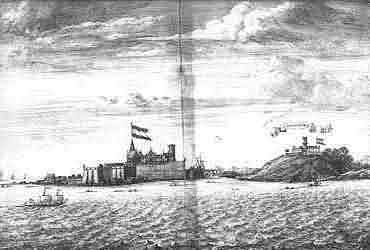Jan Pranger, "governor of the Gold Coast." In the background, an African servant. Through the window, in the distance, fort Coenraadsburgh is visible. Painting by Frans van der Mijn, 1742
Unlike the governors general of the Dutch East India Company few of the directors of the West Indies Company had their portrait painted. This is the only painting of a director general of the WIC from the company's early period. The Rijksmuseum has a portrait of a later director general, Jan Pranger, who was appointed to Elmina in 1730. In a way, Valckenburgh and Pranger mark the beginning and end of Dutch hegemony on the Guinean coast.
Dutch mercants established a trading post at MOURE on the Gold Coast in the dying years of the 16th century. After a Portuguese attack on the Dutch trading post in 1610, the Dutch built FORT NASSAU there in 1612; it was the Dutch headquarters in the region until it was moved to ELMINA in 1637.
In 1621 the Dutch United West India Company (WIC) was founded, and Fort Nassau became it's property. After several futile attempts, the Dutch took Portugal's main stronghold, Elmina, in 1637. The WIC moved it's regional headquarters there.
The Gold Coast forts were important for the trade in both gold and African slaves, the latter a factor of growing importance due to the Caribbean sugar boom. The Dutch Navy was dominant during the earlier decades of the 17th century, taking a number of Portuguese and later Swedish forts by force. In the 1660es it was Dutch forts falling to the English; most were handed back to the Dutch in subsequent peace treaties.
In 1717-1725 the GWIC acquired Brandenburg's property and claims on the Gold Coast by purchase.
In the later half of the 18th century, the Dutch experimented with cotton plantations on the Gold Coast. Toward the end of the century the slave trade, outlawed by the British in 1807, declined. The British navy did not even bother to occupy the Dutch forts on the Gold Coast. Early in the 19th century, a number of Dutch forts - now under the administration of the Dutch Ministry of Colonial Affairs, as the GWIC, successor to the WIC, was declared bankrupt in 1792 - were abandoned. In 1872, the Netherlands ceded (sold) it's property and claims on the Gold Coast to Britain, in return for Britain conceding the Sultanate of Aceh to the Netherlands (Sumatra Treatise). The price for Elmina and the Dutch property/claims was 47,000 Guilders.
Dutch Forts in West Africa, 1598-1872
Arguin
Goree
Axim
Fort Hollandia
Fort Dorothea
Fort Batenstein
Fort Oranje
Elmina
Fort Nassau

WIC trading places in 1650
In 1621 the West India Company (WIC) was established with the aim to capture as many Spanish ships ("privateering") with, already in 1628, most famous feat Piet Heijn. The yield was the siege of 's-Hertogenbosch in 1629 financed. The counterpart of the WIC, the VOC established in 1602, had a very different purpose: trade. The MIC, however, had initially as main goal, foiling the enemy of Spain (and Portugal, was part of the Spanish kingdom) But after a few years broke all the insight by the sugar cultivation is also quite attractive could be. In 1629, a area in Brazil from the Portuguese conquered. Under the leadership of Count Johan Maurits van Nassau Siegen the area came to full bloom. The shortage of slaves was so great and the WIC decided to organize this trade for itself. In 1637 was Fort Elmina on the Gold Coast (now Ghana) conquered the Dutch continued to hold until 1872 ....... Unfortunately for the WIC, had to be in Brazil in 1654 again transferred to the Portuguese. The lucrative revenues from sugar cultivation and especially the slave trade had to be prosecuted somewhere else ....... In Suriname all settlements were founded mainly by Zeeland merchants. However, since the slave trade yielded more than the cultivation of sugar, were the settlements (even then so already) in the most inexpensive way developed. In the Dutch East Indies, the VOC developed another policy! It was therefore not surprising that even the presence of the British they were much more successful. Governor Bryan even left Fort Willoughby (Willoughby was then governor of West Indies) building for protection against Indians and Zeeland.

Elmina and fort Coenraadsburg about the middle of the eighteenth century. From Barbot, Description of the North and South Coast of Guinea, London 1746







No comments:
Post a Comment